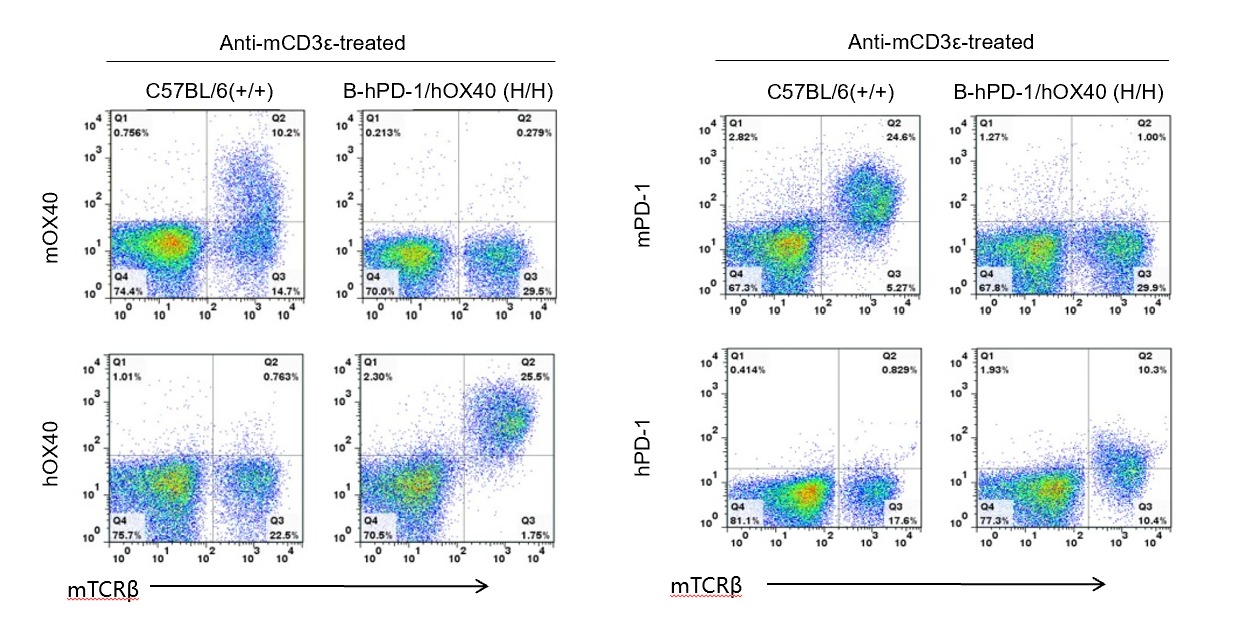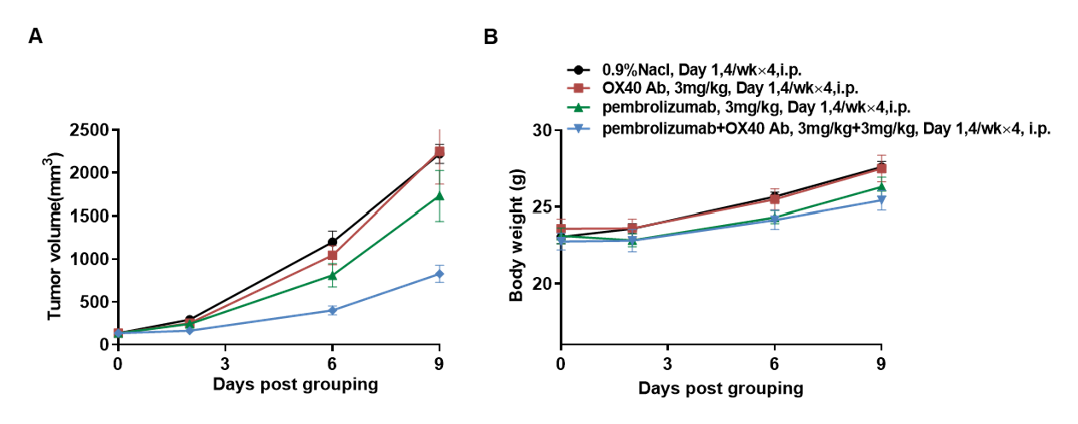Basic Information
-
Targeting Strategy

-
Gene targeting strategy for B-hPD-1/hOX40 mice. The exon 2 of mouse Pd-1 gene that encode the extracellular domain was replaced by human PD-1 exon 2 in B-hPD-1 mice. The exons 1-5 of mouse Tnfrsf4 gene that encode the extracellular domain were replaced by human TNFRSF4 exons 1-5 in B-hOX40 mice. The B-hPD-1/hOX40 two knock-in model, was developed by breeding the B-hPD-1 mice and the B-hOX40 mice, has a functional mouse immune system.
-
mRNA expression analysis

-

Strain specific analysis of OX40 and PD-1 gene expression in WT and B-hPD-1/hOX40 mice by RT-PCR. Mouse Ox40 and Pd-1 mRNA were detectable in splenocytes of wild-type (+/+) mice. Human OX40 and PD-1 mRNA were detectable in B-hPD-1/hOX40 homozygous mice .
-
Protein expression analysis

-

Strain specific OX40 and PD-1 expression analysis in homozygous B-hPD-1/hOX40 mice by flow cytometry. Splenocytes were collected from WT and homozygous B-hPD-1/hOX40 (H/H) mice stimulated with anti-CD3ε in vivo (7.5 μg/mice), and analyzed by flow cytometry with species-specific anti-OX40 antibody. Mouse OX40 and PD-1 were exclusively detected in WT mice. Human OX40 and PD-1 were exclusively detected in homozygous B-hPD-1/hOX40 but not WT mice.
-
Combination therapy of PD-1(pembrolizumab) Ab and OX40 Ab

-

Antitumor activity of anti-hOX40 antibody combined with anti-hPD-1 antibody pembrolizumab in B-hPD-1/hOX40 mice. (A) Anti-hOX40 antibody combined with anti-hPD-1 antibody pembrolizumab inhibited MC38 tumor growth in B-hPD-1/hOX40 mice. Murine colon cancer MC38 cells (5×105) were subcutaneously implanted into homozygous B-hPD-1/hOX40 mice (female, 6-7 week-old, n=6). Mice were grouped when tumor volume reached approximately 150±50 mm3, at which time they were treated with anti-hOX40 antibody combined with anti-hPD-1 antibody pembrolizumab with doses and schedules indicated in panel (B) Body weight changes during treatment. As shown in panel A, combination of anti-hOX40 and anti-hPD-1 antibody shows more inhibitory effects than individual groups, demonstrating that the B-hPD-1/hOX40 mice provide a powerful preclinical model for in vivo evaluating combination therapy efficacy of hOX40 antibodies and hPD-1 antibodies . Values are expressed as mean ± SEM.

Antitumor activity of anti-hOX40 antibody combined with anti-hPD-1 antibody pembrolizumab in B-hPD-1/hOX40 mice. (A) Anti-hOX40 antibody combined with anti-hPD-1 antibody pembrolizumab inhibited B16-F10-hPD-L1 cells tumor growth in B-hPD-1/hOX40 mice. Murine colon cancer B16-F10-hPD-L1 cells (1×105) were subcutaneously implanted into homozygous B-hPD-1/hOX40 mice (female, 7-8 week-old, n=5). Mice were grouped when tumor volume reached approximately 150±50 mm3, at which time they were treated with anti-hOX40 antibody combined with anti-hPD-1 antibody pembrolizumab with doses and schedules indicated in panel (B) Body weight changes during treatment. As shown in panel A, combination of anti-hOX40 and anti-hPD-1 antibody shows more inhibitory effects than individual groups, demonstrating that the B-hPD-1/hOX40 mice provide a powerful preclinical model for in vivo evaluating combination therapy efficacy of hOX40 antibodies and hPD-1 antibodies . Values are expressed as mean ± SEM.


